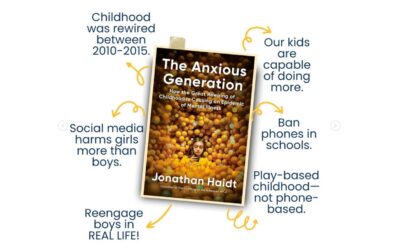 When I was around age ten, I remember my parents telling me that it would be best if I completely avoided alcohol, cigarettes, and drugs. “We have a family history of addiction,” they told me. It was a clear warning so I could make an educated choice.
When I was around age ten, I remember my parents telling me that it would be best if I completely avoided alcohol, cigarettes, and drugs. “We have a family history of addiction,” they told me. It was a clear warning so I could make an educated choice.
Those conversations changed everything for me. As I grew up, I steered clear of alcohol, cigarettes, and drugs. I realize that some people are highly-functional and can control their drinking and other habits. That wouldn’t have been me.
Years later I’m in good health and free of those addictions because they never had a chance with me.
As children of the 80’s and 90’s we were taught about alcohol and drug addiction. Today there is a new type of addiction on the rise—technology addiction, and it is our job as parents in the digital era to teach our children about it.

How do we know that technology addiction is real? Researchers use brain scans to demonstrate how playing a video game or using social media can affect our brain. They have found that we get a dopamine “tickle” from using technology, more so from video games and virtual experiences. “Dopamine is the feel-good neurotransmitter that’s the most critical element in the addiction process.” (Glow Kids*, p. 60. See our review here.)
Our brain really likes the dopamine rush we get from doing pleasurable activities. It is addicting to our brain. Our brain wants to have that feeling again and again.
While addiction to drugs may look different than addiction to technology, they can both destroy relationships and keep us from living a balanced life.
So, how do we know if we or someone we love is actually addicted to technology? Here are a few warning signs:
-
- Lack of interest in once-loved activities.
-
- Isolation for long periods of time with a device.
-
- Not doing homework or gradually losing interest in school or work in general.
-
- Not sleeping well.
-
- Acting defensive when the topic of device use comes up.
- Frequent meltdowns or aggressive behavior when a device is out of reach or it’s time to get off the device.
If you, your child, or spouse show any of these signs, consider it a warning of a potential addiction.
If you feel someone in your family might be borderline addicted here are five strategies to help:
- Have a one-on-one daily check in. I have one child that just really likes to watch YouTube videos! Even with limited screen time and using devices in public areas, I feel the need to check-in with this child regularly through a conversation. I might ask, “Have you found anything fun to watch on YouTube? ,” or “What are you favorite things to watch on YouTube these days?” And then I try to listen more than I talk.
Daily check-in conversations like these work best when tied with a bonding activity, which leads to a more natural conversation. Some of our favorite bonding activities include: a short back-rub, a walk, a quick run to the grocery store, turning on some music and sitting on the bed together, drinking smoothies, reading a chapter book together, preparing dinner together, jumping on the trampoline, or playing catch. The idea is to really connect with the other person, even if it’s only for five minutes.
Even though we haven’t experienced addiction problems with our kids yet, we still have a check in with one another when we notice anyone’s habits deviating from our family technology plan. I have watched family members model this with true addiction and over time, this daily accountability is so powerful.
- Establish tech limits with your kids. We decided that our kids needed to take ownership in deciding how our family would use technology. This lead to the creation of our Family Tech Think Tank.
We held several strategy sessions with our kids to create a Family Technology Plan. Together, we decided where we will use screens, what we will use on them, when it is appropriate to use them, and for how long. This helped us to establish healthy boundaries with the devices in our home. Kids who understand why they are doing something are more likely to cooperate.
- Talk to your children about the dangers of technology addiction. I wonder what would have happened if my parents hadn’t talked to me about my potential genetic disposition toward substance abuse? Sure, I heard it from others, but my parents’ opinions mattered most. And no one knew me as well as my parents. Most teenagers would never let you believe that they even care about your opinion. While they may never say it, they care more than you think.
Talking about addiction is not an easy conversation to have. Not long ago I engaged in an emotionally charged conversation with one of our children about smartphones. Since then, I’ve learned to listen more than I talk. This isn’t failure. This is real life and I’m a parent who cares enough to try. So are you.
- Be willing to reevaluate. A wise friend told me something his mother always said: “I reserve the right to be wiser today than I was yesterday.” I’ve said this to my own kids more than once! We followed this advice when we replaced our teen’s smartphone with a feature phone.
If my husband, myself, or any of our children, feel we are experiencing borderline addiction, we take a step back by eliminating that distraction for a week or two. If you try this and it doesn’t help, Dr. Victoria Dunckley, author of Reset Your Child’s Brain*, recommends a four-week electronics fast.
- Identify unmet needs. Sometimes my kids or I want to unwind from the day with technology. Why is that? Does scrolling Instagram or watching YouTube videos really help us to unwind?
Sometimes we turn to a favorite mindless habit when we are trying to meet a need. We turn to technology to find comfort.
But if I think back to my day and consider my unmet needs, I might realize what I really need is some fresh air or sleep. The real power comes when we can replace our mindless scrolling habit with an activity that will actually replenish our mind, body, or soul.
Addiction isn’t necessarily on the horizon for everyone, but being aware and prepared to meet it is much better than feeling fearful and unprepared.
Remember you can check in with your kids on a daily basis, establish tech limits, talk about the dangers of addiction, be willing to reevaluate your tech policies, and identify unmet needs. These five strategies will serve you even if you feel your family is simply slipping into some undesirable screen time habits.
And if you or someone you love has a serious technology addiction, please do not hesitate to get professional help. There is always a road back to a balanced life. Technology is an amazing tool. We just have to remember to make sure it’s serving us and not the other way around.
*As an Amazon Associate I earn from qualifying purchases.



